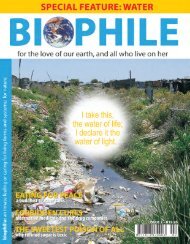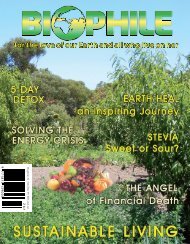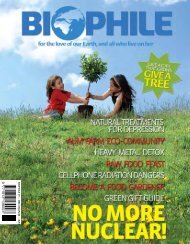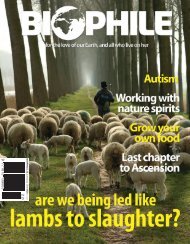SimplySustainableby Nirmala NairAs Sustainability discourses becomea buzz word, a household topic,it has become more confusing -removed from ordinary people’sperspective.Yet the very essence ofsustainability lies in its simplicity,and its accessibility to any layperson.We are living in an extremelyspecialized world where the simplestuff is often forgotten. The way ofcommonsense is pushed aside foran apparently more sophisticatedproduct approach to life - like theorganic insect spray in a fancyplastic bottle instead of the good oldgarlic-chilli mixture, and marigoldsand companion planting to maintaininsect free veggie patches.The focus of this column will be to1. Dig out the much forgotten ‘goodold’ways of living, simply usingcommon sense and nature’s wisdom,learning to dance with nature2. Share from around the worldsimply sustainable living narratives- stories about real people livingsimply and sustainably notbecause they believe it is ‘cool’or fashionable, because that is allthey know, because they have notbeen polluted by ‘development’;because they have not progressed(regressed?) into sustainabledevelopment.Often these stories are tools forreflection – to look deeper intothe well meaning well-intentionedprojects to ‘De-velop’ that are oftenfilled with contradictions. Most oftenthe damages and destructions facedtoday are the resultant outcomeof such development projects thatforce communities to compromisethe process of living simply with in alocal context.A touch of madness...touched by modernityStories from Payyallore, a tiny village nestled under thefoothills of Western Ghats of Palakkad province in Kerala,South IndiaThis tiny little village, my home-town,now boasts more than ten busesplying through the only dusty mainroad. The majestic backdrop of theWestern Ghats made this little villagepicturesque, almost out of a livingcanvass of nature.Every couple of years I return tothe village only to be shocked to seeanother development… another paddyfield filled up to construct another horrendousconcrete building. The numberof old buildings in the area are vanishingfast. No more mud bricks. No moreKerala style old buildings with timber,stone and mud bricks or the poorerhomes with thatch equivalent palm leafroof structures with bamboo supports.Bamboo used to be the main fencingmaterial, but has been totally replacedwith either brick walls or barbed wirefencing or a combination. When I livedat home, my mother lovingly cultivatedmany shade loving trees interspersedwith the bamboo fencing, making itmore like a green wall. Most of thesewere Neem and another local specieswe call vaka, the bark of which wasused for soap. The touch of modernitybrought home by my retired father sawthe demise of the entire Neem familyfrom our homestead along with thebamboo fence now replaced with a concretewall and barbed wire fencing.Concrete and brick housing hasbecome a symbol of upward mobilityand status. The emerging constructionindustry has moved to all corners, buyingup paddy fields and luring the localsto lease their land for brick kilns.Scattered across the paddy fields,spewing smoke and fume, stand thebrick kilns – bringing modernity to thehomes around. Studies after studieshave shown that brick kilns are killingthe fields, making the land unarable foryears. But the construction industry ishungry for bricks; people want concretehouses. Mud bricks are not fashionable.Laborers are not interested in buildingwith mud bricks. And are losing theknowledge.And yet…far away in towns, tired ofmodern buildings, sustainable architects24 <strong>Biophile</strong> Issue <strong>16</strong>
have been working with compressed earthblocks for many years. Take Auroville aneco-township in Pondicherry, the southof India. Led by Sat Prem Mani, who hasdedicated his life to working on sustainablearchitecture, the Earth Institute hasdeveloped multiple ways of working withcompressed earth blocks, practical, sustainable,labor intensive as well as ableto meet the demand in volume, if need be— contrary to the constant criticism thatproponents of cob-house and such otherdesigns have to hear from mainstreamurban housing Mafioso.What is most disturbing is the trend todiscard what has been working generallywell, adopt something that is new and inthe process destroy the foundation of whatdid work previously, only to discover thatwe may have to go back and improvisewhat was working before. By this time, acouple of decades have gone by, generationsdestroyed.Is there a better way to learn, becomewiser, wake up to the reality of appreciatingwhat one has, exploring the possibilitiesof building on what is locally available?Is there a better way to bridge commonwisdom without losing it entirely?Is there a way to support local craftsmenand women without becoming slavesto sustainability experts busy taking overthe few craftspeople with local knowledge?Is there a way of making sustainabilitychoices accessible to all ?Is there a way to create consciousnessaround sustainability stemming from aneducational paradigm that facilitates oneand all to make conscious choices aboutpro-active citizenry?Is there a way of thinking that becomesthe norm, the backbone of any societythat enables citizens to challenge unethicallifestyles being promoted by businesscouched as good living?Take the case of Payyallore, my village.People have become conditionedto the idea of a false notion of modernity.Swept by the winds of modernisationold and new alike suffer from feelings ofshame. Shame of being old fashioned,shamed of the old dwellings. Shamedwearing old fashioned clothing. Shamedat the unaffordability to buy the glitteringnew materials goods that the shopsare inundated with.Purchasing power of the money islow. People’s ability to sustain themselvesis great but is afflicted, dis-easedunder the onslaught of glitzy media andtelevision giving evangelical gospelsabout good living.In our little small holding my motherplanted almost everything we needed.There was very little we needed to buyfrom outside, soaps, textile perhaps…even the textiles came from the nearbyweaver. The pots that my mother cookedcame from the local potter.The small holding went through amake-over once my father returned,retired from the military. A victim ofmodernity syndrome, he came to livein the village full of new ideas, deeplyconvinced of the need to modernizevillage life. Totally skeptical about oldways, rituals and festivals, temples anddeities. He pooh-poohed all of this asnonsense, superstition and doomed tokeep the villagers, ‘lazy and backward’.Where my mother did veggie patcheswith companion planting, trees andshrubs and bushes growing in harmony,my father cleared the land. Where shemanaged with one well to water her entireveggie patches, my father got a borewell and motorized pumping.My father believes true developmentmust be accompanied by real technologies.His real technologies have chasedthe humus away from the garden, thelush undergrowth, mostly edible weedshave become a forgotten species of thepast. No more frogs in the garden, nomore snakes and no more abundance ofbird life that always sought lush greengardens and insect life as their priorityliving habitats.My father opted for cash crops thatdon’t generate immediate returns butthat may yield income in four to fiveyears. By that time, if he is lucky theprices will be good. But the market isnot a dependable mechanism and mustnot be the core determining factor inthe pursuit of sustainability.Years and years of accumulatedhumus and undergrowth gone. The soilexposed to harsh tropical sun had tobe coaxed to produce anything. The tallgrowing coconut planted mainly as cashcrop casting ever longer shadows preventedlush undergrowth and no humusto accumulate.The small holding, that grew enoughfor a family of five soon became dry,parched barren naked soil with no undergrowthto hold the moisture duringthe dry hot season and no undergrowthto drink and absorb the excess moistureduring heavy monsoon.After many years, of working passionatelyin the garden my mother withdrewfrom the modernist male domainespecially after her daughters left home.She neatly put away her few pieces ofgardening equipment, a small sickle, apick and a hoe, became aloof. Her essenceof life, her garden shriveled awayin the tropical sun as her body witheredwith gloom and despair, the male waysNirmala Nair(ZERI Southern Africa, Cape Town)Nirmala Nair has been involved in sustainabledevelopment initiatives for thelast 25 years. She consults, lectures andconducts training workshops nationally andinternationally on whole systems inspiredsustainable practices for local developments.Born in Kerala, raised in Kashmir andNew Delhi, she was home schooled by hermother until the age of 10. She believes thatthe roots of her passion to do sustainabledevelopment differently from lies in beingraised in a simple but sustainable life style,free of formal factory schooling, which soeasily thwarts creative, innovative potentials.She has a Masters Degree in Sociology fromJawaharlal Nehru University, New Delhi anda Masters Degree in Development Studiesspecializing in Women and Developmentfrom the Institute of Social Studies, TheNetherlands. She has been living in CapeTown since 1992 with her South Africanhusband, Philip van Ryneveld, and her threedaughters,Nirmala’s quest has been seeking solutionsbasedsustainability approaches, locallydesignedand rooted in local cultures andtraditions. She believes that external,technocratic interventions alone are notgoing to be sufficient to create a paradigmshift. Her work in this respect is focused onenvisioning self organizing bio-regionalzonesthat sustains and regenerates localeco-systems and communities in truesustainable abundance.She is the founder director of ZERI-SA (ZeroEmissions Research and Initiatives - SouthAfrica) www.zerisa.orgof living too harsh for her soulful living.She became bed ridden…for manyyears, just waiting to move on, whichshe did last year. She passed away onmy lap, looking into my eyes in despairand fear for what awaits humanity. I hadto reassure her, it is okay to leave, themodernity era is coming to an end, thegoddess era is awakening.Many women removed from the landget sick… so many women removedfrom their mothers’ gardens live lifewith no meaning anymore, nothingmakes sense to their old ways of living.Men rushing, men impatient, menraking deep, machines grinding. Eyesglassy, eyes frantic, seeking searching,caught in the prison of inertia<strong>Biophile</strong> Issue <strong>16</strong>25
















